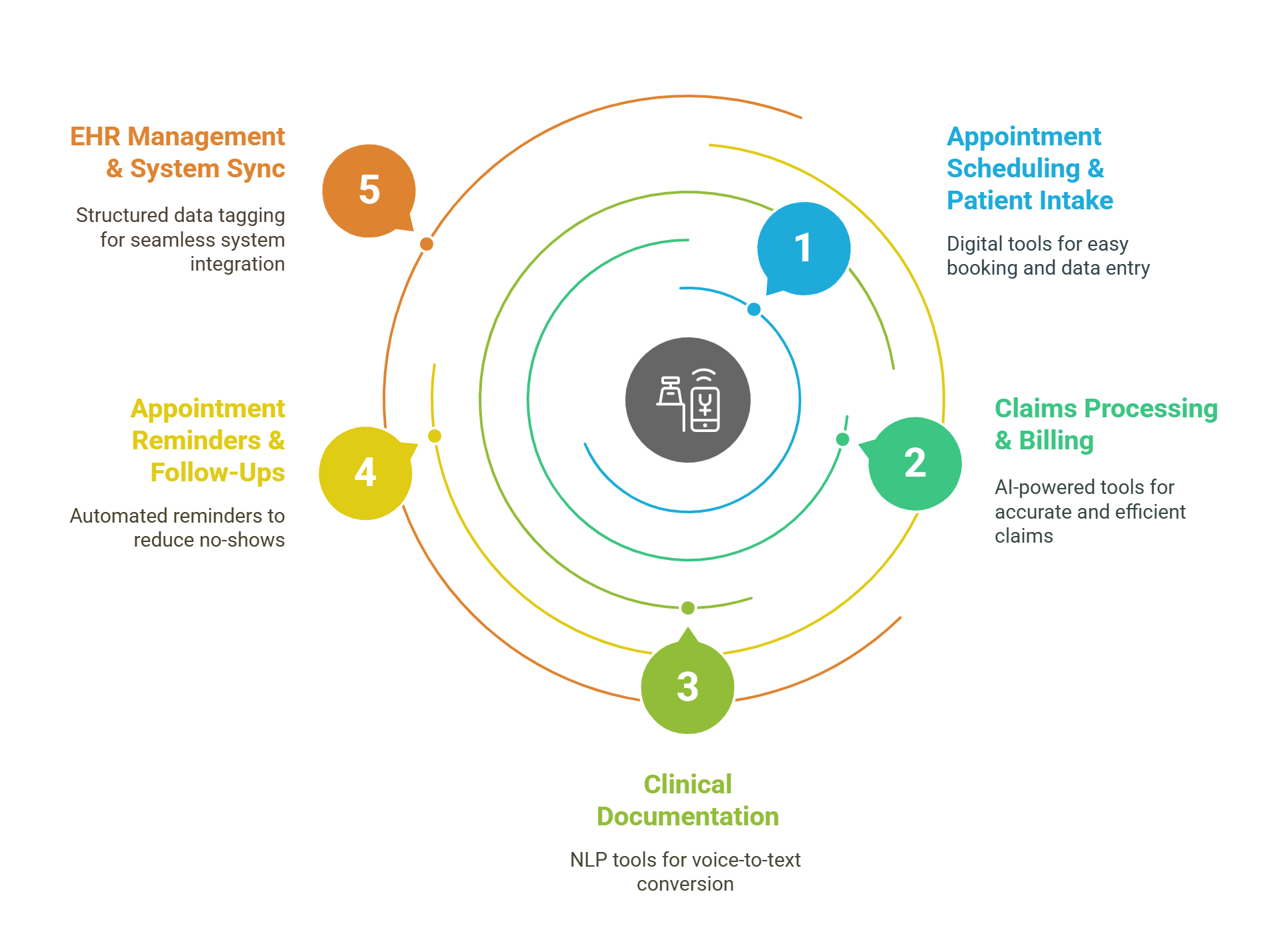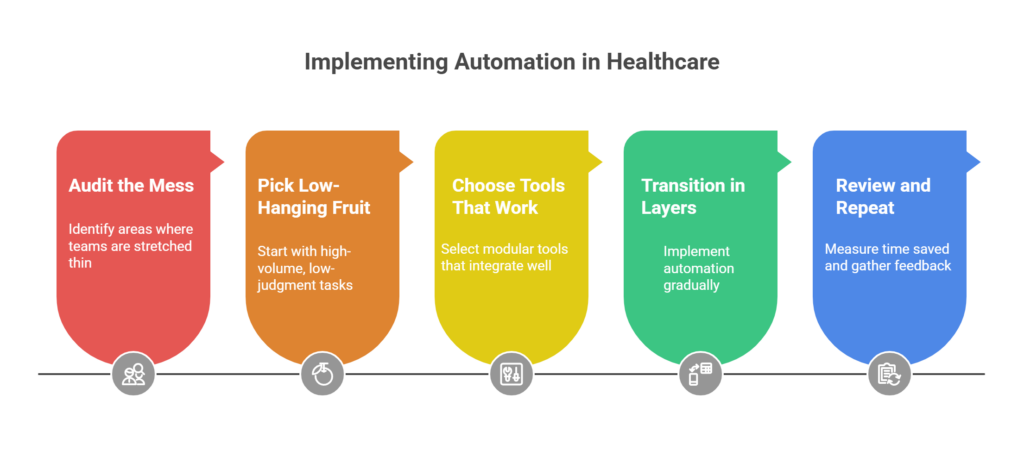Healthcare is relentless. There’s always something urgent, something critical, and rarely ever enough hands or hours. But the responsibilities? They keep piling on. There’s no off switch and no room to slack. That’s just how this sector works. But that doesn’t mean the system can’t be better.
This blog is about the kind of better that’s actually achievable. The kind that comes from administrative workflow automation in healthcare. It’s not about cutting corners. It’s about freeing time.. real time.. for actual patient care. And it starts with understanding how AI and automation in healthcare are changing the game.
AI and Automation in Healthcare: Why It Matters Now
We’re not talking about robots doing surgery. We’re talking about automating the repetitive backend processes that eat up doctors’ and admins’ time. AI automation in healthcare is finally addressing what the industry has quietly accepted as the cost of doing business: manual workflows, endless data entry, appointment scheduling, insurance claims, and follow-ups.
With intelligent healthcare workflow automation, we’re not replacing humans. We’re freeing them.
It’s about making sure healthcare professionals aren’t stuck doing tasks a machine could do better and faster. Think: scheduling appointments, verifying insurance, handling paperwork, managing records. If it’s repetitive and rules-based, it’s probably automatable.
And when you automate these workflows, what you actually do is give doctors, nurses, and staff back some breathing space. More time with patients. More attention to care. Less cognitive load. Healthcare workflow automation helps everyone, from admin teams to clinicians, do what they’re meant to do.
Top 5 Areas Where Automation Saves Time in Healthcare

1. Appointment Scheduling & Patient Intake
No more clipboard chaos. Digital scheduling tools let patients book and reschedule anytime. Online forms and real-time insurance checks mean less waiting room data entry and fewer front desk bottlenecks.
2. Claims Processing & Billing
AI-powered tools review claims for accuracy, flag issues that cause rejections, and auto-submit them. This speeds up approvals and minimizes follow-ups.
3. Clinical Documentation
NLP tools turn voice recordings into structured notes. Providers can dictate instead of type, saving time and reducing burnout.
4. Appointment Reminders & Follow-Ups
Automated SMS or email nudges reduce no-shows. Systems can even send post-visit reminders or care instructions without staff intervention.
5. EHR Management & System Sync
Clinical workflow automation now includes structured data tagging, smart syncing between labs, imaging, and pharmacy records—so everything’s in one place when it counts.
Bonus Considerations
- Lab and Imaging Automation: Triggered updates and automatic alerts when results arrive. Nobody needs to chase.
- Internal Record Integration: AI helps consolidate files from different systems, reducing toggling and missed info.
- Triage and Routing: AI-driven pre-assessment bots can handle patient questionnaires, so human staff don’t have to start from scratch.
That’s workflow automation in healthcare done with intent and it’s already working.
Which AI Companies Specialize in Healthcare Automation?
Some companies are already doing solid work here:
- Olive AI: Focused on hospital revenue cycle and back-office automation.
- Aidoc: Speeds up radiology diagnosis using AI.
- Tempus: AI-driven decision support in oncology.
- Enacton: We build scalable telemedicine solutions that’s flexible enough to match the messy realities of your clinic or hospital.
- xlwith.ai: Focused on developing AI agents that work inside telemedicine ecosystems and automate clinical workflows at scale.
Implementing AI Automation in Healthcare: A Quick-Start Guide
ome teams hesitate to bring in automation, and that’s fair. Healthcare is layered and sensitive. The hesitation often isn’t about the tech, right? it’s about whether it’ll actually support the work or just add another system to manage. But well-placed automation doesn’t override judgment. It helps reduce the clutter around it, so teams can focus on what really matters.
You don’t need to rip up your current systems. Start small and scale what works. Here’s a simplified path:

Step 1: Audit the Mess
Where are your teams stretched too thin? What tasks are done manually every single day?
Step 2: Pick the Low-Hanging Fruit
Start with high-volume, low-judgment tasks like scheduling or insurance verification.
Step 3: Choose Tools That Work With You
Avoid bloated platforms with long learning curves. Whether you need scalable telemedicine solutions or AI agent integration, go modular.
Step 4: Transition in Layers
Don’t fire-hose the change. Run automation in parallel until your team feels confident.
Step 5: Review and Repeat
Measure time saved. Get user feedback. Then build on it.
Cost vs Time Saved: What the Math Says
If your clinic handles around 100 patients each day, and staff spend just five minutes verifying insurance per patient, that adds up to over eight hours a day. By automating even this one process, you can save a full workday. Now add other tasks like appointment reminders, follow-up coordination, and intake documentation, and you start seeing where full days can be recovered. That time becomes space for better care.
Imagine a mid-sized clinic seeing 100 patients daily. If admin staff spends around five minutes per patient on manual insurance verification, that adds up to more than eight hours every day. With automation, this task takes a fraction of the time. Extend that logic to appointment reminders, follow-up calls, or claims processing and the time savings become significant. What used to be a full-time burden becomes space for better service and less stress.
What Not to Automate (Yet)
Not every task needs a tech fix. There are still things better handled by people, especially where empathy, context, or sensitive judgment is involved. Difficult diagnoses, emotional conversations, and ethical decisions are areas where automation should support, not lead. The goal isn’t to replace human insight. It’s to reduce the noise around it.
Some parts of healthcare benefit from staying human. Tasks that involve empathy, moral judgment, or complexity, like delivering difficult news, navigating mental health crises, or creating personalized care plans, need people, not protocols. Knowing where to draw that line helps teams avoid overreach and keeps the focus on care, not shortcuts.
Cultural Shift in Teams
A new tool won’t change much if the team isn’t on board. The rollout needs to feel like something that’s being done with the staff, not to them. Start small. Involve the people who’ll use the systems day to day. Let them weigh in on how things get implemented. That shared input makes the transition smoother and helps everyone trust the process.
The technology is only one part of the shift. The rest depends on people. Automation doesn’t work when it’s handed down without discussion. Teams that are brought into the process early (who understand why it’s happening and where it helps) tend to adapt better. It’s about building tools with your team, not just for them.
Real Results from Healthcare Workflow Automation
These are not just ideas. There’s data behind it:
- Voice AI for Documentation: A pilot study by the American Academy of Family Physicians (AAFP) found that using a voice-enabled AI assistant led to a 72% reduction in median documentation time per note, resulting in an average of 3.3 hours saved per week per clinician.
- Workflow Automation and Patient Throughput: HIMSS research highlights that healthcare organizations investing in workflow automation have improved patient throughput without adding headcount, by streamlining manual processes and optimizing resource allocation.
It works. If done right.
Agentic AI: What’s Next?
The new wave isn’t just automation. It’s AI agents. These aren’t passive bots. They work across systems, respond to dynamic changes, and execute complex tasks like pre-visit assessments, triage, and follow-ups.
At xlwith.ai, we’re building agentic AI for healthcare workflows. They’re especially powerful in telehealth environments, where context-switching and asynchronous care models make automation even more valuable.
If you’ve been wondering what comes after workflow rules and templates—this is it.
FAQ: AI and Workflow Automation in Healthcare
What is AI and automation in healthcare?
It refers to using intelligent systems to handle time-consuming tasks like scheduling, billing, and record-keeping—so healthcare staff can focus on care, not paperwork.
How do AI agents improve clinical workflows?
AI agents can act like digital assistants, helping with triage, assessments, and follow-ups across systems without human oversight for every step.
Can small clinics afford workflow automation?
Yes. Many tools are modular. Clinics can start with just one use case, like appointment reminders or intake forms, and expand gradually.
Is workflow automation secure for sensitive patient data?
Most reputable platforms comply with regulations like HIPAA and use encryption, access controls, and regular audits to ensure data safety.
Let Doctors Be Doctors
We didn’t build our solutions to replace care—we built them to protect it. AI and automation in healthcare are about priorities. Let doctors care, let administrators breathe, and let technology take care of the bottlenecks.
AI automation in healthcare helps you make space. The kind of space that lets your staff catch up, your doctors focus, and your patients feel seen.
It’s time we stop accepting admin chaos as the price of care.
If you’re ready to reduce that chaos, we can help. Let’s talk about it. Or check out how AI agents are helping other healthcare companies do more with less.
